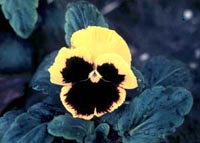Resource Library
Plant of the Week: Pansy
The University of Arkansas System Division of Agriculture does not promote, support or recommend plants featured in "Plant of the Week." Please consult your local Extension office for plants suitable for your region.
Plant of the Week
Pansy
Latin: Viola x wittrockiana

In our highly technical era, we often assume that only experts in a field can make a difference. In gardening, individual gardeners are the experts and most of the plants we enjoy in our gardens today sprang from the efforts of individuals, not plant breeders working for giant seed companies.
The pansy is such a plant. Pansies have become the most popular winter bedding plant across most of the milder parts of the U.S. in the past several decades. If planted in the fall, the preferred time, they will begin blooming in November but the greatest concentration of flowers appears during the cool moist spring from February through May.
Pansy is one of our earliest garden flowers, being cultivated since at least the 16th Century in England. Originally, the pansy flower was either singly colored in shades of yellow, blue or violet or had two petals of one color and three of a second color. Flowers were small, less than an inch in diameter.
The modern, large flowered pansy owes its existence to Englishman William Thomson, who worked with the flower between 1814 and 1839. He crossed the native johnny-jump-up (V. tricolor) with a yellow-flowered wildflower (V. lutea) and a blue-flowered Russian violet called V. altacia. The dark colored face – a blotch that is produced on the lower petals – appeared as a chance seedling and, after development, was released as the variety Medora in 1839. Thomson worked on the estate of Lord Gambier, in Iver, northwest of London. The faced pansies became the rage in England during the 19th Century. Pansy shows were held to judge the most perfect kinds, just as rose and orchids shows are held today.
Pansy colors have been extended to include orange, white and black flowers.
These show pansies were not of much use in the garden because they were selected just for floral features, not good flower bed characteristics. As the Victorian era progressed, gardeners began selecting plants that were well branched and compact and better suited for use in the intricate bedding schemes of the day.
Pansies are best planted in the garden in October or early November with a plant spacing of 8 to 10 inches to give good bed coverage. They perform best in full sun but will bloom in light shade. They are not heavy feeders, but do need some nutrition to continue a good spring display. A light fertilizer application at planting with a top dressing of 13-13-13, applied at the rate of one half pound per 100 square feet in February will usually suffice.
Pansies will be green all winter throughout Arkansas. If the winter is unusually dry, they must be watered. As the night temperatures increase above 65 degrees pansies begin to stretch, flower size gets smaller and the plants look unsightly and should be replaced with summer bedding plants.
By: Gerald Klingaman, retired
Extension Horticulturist - Ornamentals
Extension News - November 13, 1998
The University of Arkansas System Division of Agriculture does not maintain lists of retail outlets where these plants can be purchased. Please check your local nursery or other retail outlets to ask about the availability of these plants for your growing area.